Selected Publications

In an advanced acoustics laboratory course at Brigham Young University, students are introduced to ANSI measurement standards in the context of sound power. They are introduced to the anatomy of a typical acoustics standard and then plan and carry out sound power measurements of an electric leaf blower usingbothreverberationchamberandsoundintensitymethods. Thestudentsarerequiredtowriteatechnical memorandum describing a) the blower’s radiated sound power levels over an appropriate frequency range, asobtainedwiththetwomethods;b)setupdocumentationanddeviationsfromthestandards’recommended practices;andc)howanydeviationsmighthavecontributedtodiscrepanciesbetweenthesoundpowerlevels obtained with the two methods. In this paper, a description of the experience is given, along with overall impressions and plans for future improvements.

Kent L. Gee and Tracianne B. Neilsen (et al.)
Development of the next-generation space flight vehicles has prompted a renewed focus on rocket sound source characterization and near-field propagation modeling. Improved measurements of the sound near the rocket plume are critical for direct determination of the acoustical environment both in the near and far-fields. These measurements are also crucial inputs to empirical models and utilized in validating computational aeroacoustics models. NASA’s SP-8072 acoustic load prediction model [K. M. Eldred, NASA SP-8072 (1971)] is a widely used empirical model for predicting liftoff acoustics. The model implements a Distributed Source Method, which predicts the loading as the sum of the radiated acoustic pressure field from each source distributed along the plume. In this paper, the resultant sound distributions are compared among the original core length definition in SP-8072, a modification proposed by Varnier [J. Varnier, AIAA Journal, Vol. 39, No. 10, (2001)], and four full-scale solid rocket motor tests with measurements covering a spatial region of 9 to 56 nozzle diameters downstream of the nozzle. The results of the comparisons support the original Eldred core length definition on an overall level basis. However, analysis of the measured spectra unveil shortcomings within both definitions.

S. Hales Swift, Kent L. Gee, and Tracianne B. Neilsen (et al.)
Crackling signals cannot be identified using any sound level or quality metric that relies solely on the long-term spectrum as input. In order to identify sound quality metrics that might succeed in modeling human perception of crackling and non-crackling sounds a set of metrics sensitive to temporal properties of signals is applied to a set of signals with equivalent spectra but exhibiting varying degrees of crackle. Several methods for altering signals including some that remove crackling sound quality from an acoustic signal were drawn from previous work [Swift, Gee, Neilsen, 2014, Swift, Gee, Neilsen, 2017]. In this paper, an additional alteration which can partially remove crackle—randomizing the Fourier phase of a crackling signal in the frequency domain in selected frequency ranges—is considered. Variables from time-varying sound quality metrics such as loudness and sharpness, as well as roughness to signals exhibiting varying degrees of crackle are explored and relationships between them that can be exploited to identify crackling sounds are identified. Time-sensitive sound quality metrics can be used to discriminate between crackling and non-crackling signals and may help inform discussions of human perception of high-performance jet noise.

S. Hales Swift, Kent L. Gee, and Tracianne B. Neilsen
The jet sound quality “crackle” has historically been studied and quantified using the statistics of the pressure waveform. Some investigators have suggested crackle, and its associated shock content, may be better quantified using the statistics of the time derivative of the waveform. Modified waveforms are used to evaluate crackle prediction criteria based on the skewness of each variable. The resultant waveforms are provided as direct evidence that the pressure distribution does not directly predict or quantify a crackling sound quality while the statistics of the derivative appear to do so.

Alan T. Wall, Kevin M. Leete, Kent L. Gee, and Tracianne B. Neilsen (et al.)
An understanding of jet noise source mechanisms can facilitate targeted noise reduction efforts. This understanding has been enhanced with acoustic imaging technologies, such as near-field acoustical holography (NAH). In this study, multisource statistically optimized NAH (M-SONAH) was used to image the sound field near a tethered F-35 aircraft at multiple frequencies. A linear microphone array, placed along the ground, spanned the length of the jet exhaust plume. A multisource model of the sound field was included in the algorithm to incorporate the effects of the ground reflection on the measurement. Narrowband reconstructions elucidated fine details of the radiation patterns, such as multilobe radiation patterns (which may supersede “dual-lobe” patterns shown in previous studies), and broadband shock-associated noise. [Work supported by F-35 JPO.]

Kent L. Gee, Tracianne B. Neilsen, and Mylan R. Cook (et al.)
A new method for the calculation of vector acoustic intensity from pressure microphone measurements has been applied to the aeroacoustic source characterization of an unheated, Mach 1.8 laboratory-scale jet. Because of the ability to unwrap the phase of the transfer functions between microphone pairs in the measurement of a radiating, broadband source, physically meaningful near-field intensity vectors are calculated up to the maximum analysis frequency of 32 kHz. The new intensity method is used to obtain a detailed description of the sound energy flow near the jet. The resulting intensity vectors have been used with a ray-tracing technique to identify the dominant source region over a broad range of frequencies. Additional aeroacoustics analyses provide insight into the frequency-dependent characteristics of jet noise radiation, including the nature of the hydrodynamic field and the transition between the principal lobe and sideline radiation.
Theses, Captstones, and Dissertations
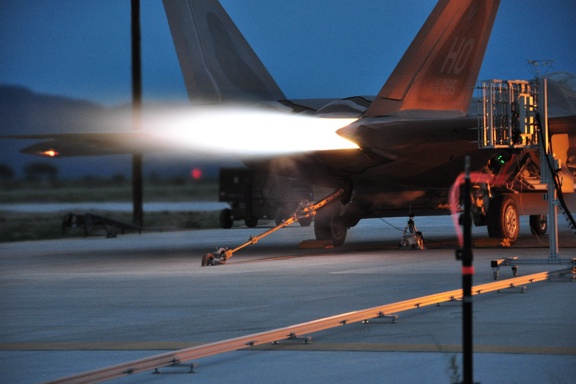
The scientific community has employed multiple methods to analyze and describe the jet noise emanating from the turbulent exhaust flow from modern military aircraft engines, with the goal that better characterization of the sound radiation will improve noise reduction efforts. This thesis utilizes three different approaches to characterize the noise source region from a static F-22A Raptor. First, the energy flow field along planes near the aircraft and along an arc is measured using a multidimensional vector intensity probe. The resulting vector intensity maps give a clear indication of the directionality of the noise as a function of frequency at different engine conditions. A straightforward ray-tracing method show the utility of vector intensity measurements in source characterization by estimating the region from which the loudest portions of sound are emanating. Second, intensity reconstructions from near-field acoustical holography (NAH) provide an estimate of the three-dimensional radiated energy flow field. The sound field is shown to be dominated by mutually incoherent radiation lobes, which can be partially isolated by a partial decomposition method. Lastly, a wavepacket source model is optimized in light of amplitude-based NAH reconstructions near the jet axis. The wavepacket model successfully fits the NAH-reconstructed partial fields, especially at frequencies above 50 Hz, indicating that the source may be modeled by multiple wave packets at each frequency.
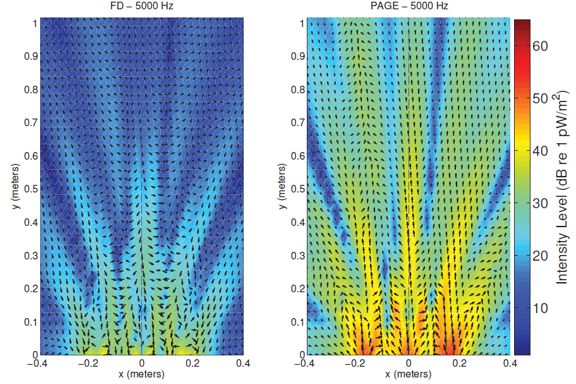
An alternative pressure-sensor based method for estimating the acoustic intensity, the phase and amplitude gradient estimation (PAGE) method, is presented. This method is similar to the finite-difference p-p (FD) method, in which the intensity is estimated from pressure measurements made using an array of closely spaced microphones. The PAGE method uses the same hardware as the FD method, but does not suffer from the frequency-dependent bias inherent to the FD method. Detailed derivations of the new method and the traditional FD method are presented. Both methods are then compared using two acoustic fields: a plane wave and a three monopole system. The ability to unwrap the phase component of the PAGE method is discussed, which leads to accurate intensity estimates above previous frequency limits. The uncertainties associated with both methods of estimation are presented. It is shown that the PAGE method provides more accurate intensity estimates over a larger frequency bandwidth. The possibility of using a higher-order least-squares estimation with both methods is briefly demonstrated. A laboratory experiment designed to validate the PAGE method was conducted. The preliminary results from this experiment are presented and compared to analytical predictions. Finally, the application of the PAGE method to a static rocket test firing is presented. The PAGE method is shown to provide accurate intensity estimates at frequencies that are higher than possible with just the FD method.
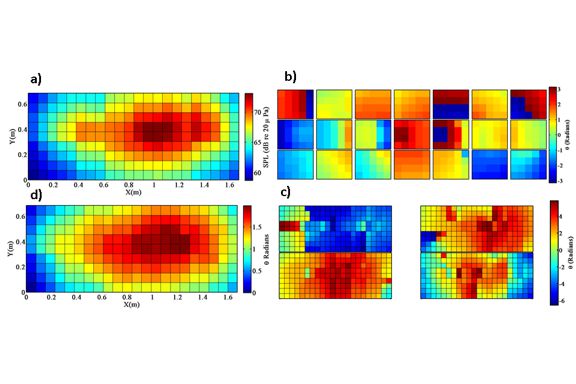
In scan-based array measurements, stationary reference sensors are needed to temporally correlate the different measurement scans and produce coherent complex pressure fields that can be used to perform near-field acoustical holography (NAH). Because the number of references required increases with the number of subsources contributing to the sound field, an extended, partially correlated source (e.g., a turbulent jet) comprising many ill-defined sources can result in significantly increased measurement complexity and expense. Demonstrated here a is a new approach to creating spatiotemporally coherent pressures using self-referencing between overlapping measurement positions instead of separate reference channels. A laboratory experiment was designed and the data have been used to explore "stitching" together a complex pressure field. This experiment is described and the “stitching” method is detailed. To successfully execute the technique, unwrapping of intrascan phases is first accomplished with a two-dimensional phase unwrapping algorithm. Individual scan positions are then stitched together using median phase differences between multiple adjacent scans to create coherent planes of data. Amplitude-stitching is done by averaging across scans and preserving the integrated squared pressure across the overall aperture. The validity of this method is shown by showing that a consistent local coherence maintained through the stitching process. The technique is applied to jet noise, and the possibility of applying it to NAH is discussed. This technique provides direction for efficient experimental design for scan-based array measurements of extended sources.
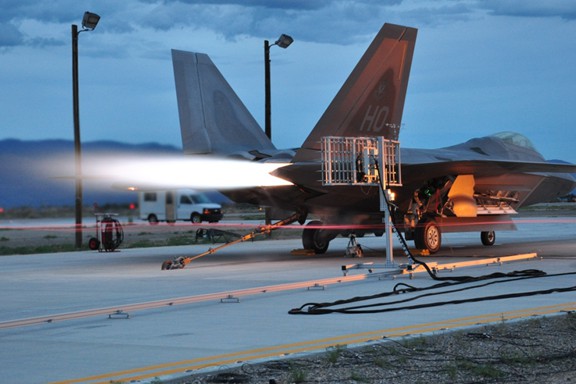
Acoustic intensity measurements of the F-22A Raptor are analyzed as part of ongoing efforts to characterize the noise radiation from military jet aircraft. Data were recorded from a rig of microphones and an attached tetrahedral intensity probe at various locations to the sideline and aft of the aircraft. Numerical analysis of the intensity at one-third octave band center frequencies along various measurement planes and at a 23 m radius arc reveals the magnitude and directionality of the vector acoustic intensity. Differences in the trends for low-frequency and high-frequency data are discussed and, via a simple ray tracing method from maximum intensity regions, interpreted in terms of far-field behavior and source location. In particular, the extended source region contracts and moves upstream with increasing frequency, and vector directionalities point farther toward the sideline.
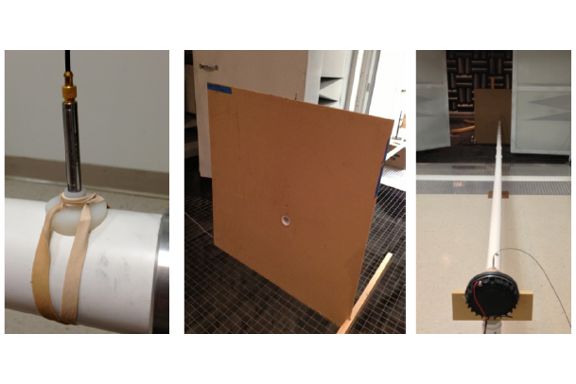
The radiation of finite-amplitude waves from the open end of a baffled, circular pipe is considered as a direct continuation of work begun by Kuhn, Blackstock, and Wright more than three decades ago [Kuhn et al., J. Acoust. Soc. Am. 63, S1, S84 (1978)]. Band-limited Gaussian noise, as well as 1 kHz, 1.5 kHz, and 2kHz sinusoidal pulses, with initial peak pressure amplitudes ranging from 0.5 – 1.2 kPa, have been propagated down a 6.1 m pipe, whose open end (5.1 cm inner diameter) has been placed off-center in a large rectangular baffle. As the steepened or shock-like waves exit the pipe, the measured waveforms are comprised of sharp impulses that are delta function-like in nature, particularly on axis. Although linear piston theory predicts similar waveform shapes, there is also evidence that nonlinear propagation of these impulses, which can exceed peak pressure amplitudes of 1.5 kPa near the pipe opening, is occurring.

Military aircraft generate high-amplitude noise which can cause injury to attending personnel. Efforts to mitigate the effects of this noise require a detailed understanding of the propagation of the noise, which was shown previously to be nonlinear. This thesis presents an analysis of highamplitude noise propagation, emphasizing measures used to quantify the importance of considering nonlinearity. Two measures of the importance of nonlinearity are compared. These measures are the wave steepening factor and a skewness estimate. The wave steepening factor is a measure of how much nonlinear waveform steepening has occurred in a waveform. The skewness estimate is the skewness of the first time-derivatives of the pressure amplitudes, and can be considered a measure of the shock content in a waveform. These two measures are analyzed analytically in terms of the Earnshaw, Fubini, Fay, and Khokhlov solutions to the Burgers equation. In addition, an analysis of how discrete sampling affects the estimation of these quantities is also presented. It is determined that the wave steepening factor is robust with respect to low sampling rates, but the skewness of the first time-derivatives of the pressure amplitudes is not robust, and requires very large sampling rates to be adequately estimated. Using numerical and experimental techniques, the two nonlinearity measures are applied to more complicated waveforms, such as Gaussian noise and noise with jet noise-like statistics. It is found that the evolution of the two nonlinearity measures discussed above for noise signals is distinctive in various ways. In particular, the skewness of the first time derivative of the pressure amplitudes suggest that noise waveforms experience nonlinear phenomena faster than initially sinusoidal signals, while the wave steepening factor suggests that they occur at approximately the same rate. The measures are then applied to full-scale military aircraft. By comparing these nonlinearity metrics with the results of the analytical, numerical, and experimental results found in this thesis, it is determined that nonlinearity is likely to be significant in the near field of a military aircraft at military and afterburner engine conditions.

The noise emissions of jets from full-scale engines installed on military aircraft pose a significant hearing loss risk to military personnel. Noise reduction technologies and the development of operational procedures that minimize noise exposure to personnel are enhanced by the accurate characterization of noise sources within a jet. Hence, more than six decades of research have gone into jet noise measurement and prediction. In the past decade, the noise-source visualization tool near-field acoustical holography (NAH) has been applied to jets. NAH fits a weighted set of expansion wave functions, typically planar, cylindrical, or spherical, t measured sound pressure sin the field. NAH measurements were made of a jet from an installed engine on a military aircraft. In the present study, the algorithm of statistically optimized NAH (SONAH) is modified to account for the presence of acoustic reflections from the concrete surface over which the jet was measured. The three dimensional field in the jet vicinity is reconstructed, and information about sources is inferred from reconstruction at the boundary of the turbulent jet flow. Then, a partial field decomposition (PFD) is performed, which represents the total field as the superposition of multiple, independent partial fields. This is the most direct attempt to equate partial fields with independent sources in a jet to date.

Microphone arrays are useful for measuring acoustic energy quantities (e.g. acoustic intensity) in the near-field of a full-scale solid rocket motor. Proper characterization of a rocket plume as a noise source will allow for more accurate predictions in engineering models that design for protection of structures, payloads and personnel near the rockets. Acoustic intensity and energy density quantities were measured in three rocket noise fields and have shown that the apparent source region of the rocket becomes smaller and moves upstream as frequency increases. Theoretical results accounting for some scattering and finite-difference errors arising in these types of energy-based measurements have been previously discussed by other authors. This thesis includes results from laboratory experiments which confirm some of this previous theoretical work as well as gives insight into the physical limitation of specific microphone array designs. Also, calibrations for both magnitude and directional response of the microphones are demonstrated. Of particular interest is the efficacy of phase calibration of array microphones for the low-frequency regime below 200 Hz.
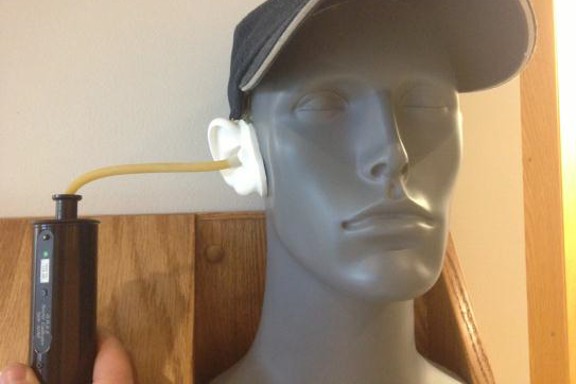
For years, the effects of sound pressure level measurements upon human hearing and psychology have been studied, and only in recent years scientists have seen a link between these measurements and headphones connected to portable listening devices. The Brigham Young University Educational Acoustics Research Study (E.A.R.S) is an interactive demonstration devoted to acquiring samples of the student body that connect findings between the use of headphones with portable listening devices, such as mp3 players, and educating individuals in the process. This report will highlight the reasoning for conducting the study, describe the proper background in acoustics needed to understand the material, and analyze the results from the study, while concluding observations. The study will evaluate the overall sound pressure level due to a one second Leq, safe listening time according to non-occupational noise criterion, and demographics that define the individual, such as age, gender, listening preference, and mp3 player. Also, the study will ask the individual about their listening habits and if they will change based around the feedback received from the E.A.R.S. This study will ultimately benefit science with information to understand connections between listening habits and safe practices of listener protection.
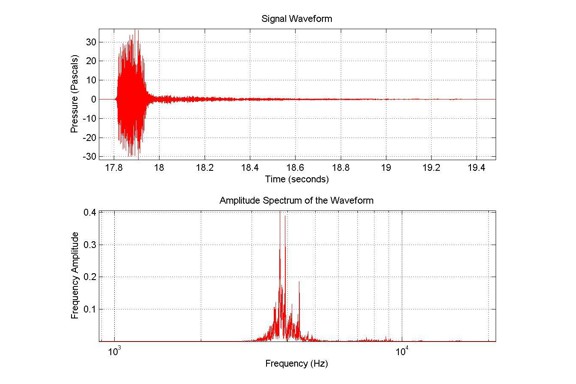
Referee whistles output high-level short duration noise that has not been thoroughly studied. Damage risk criteria (DRC) exist to quantify the overall risk of sound exposure for continuous noise (OSHA, 1981; NIOSH, 1998) and other DRCs are intended for use with impulse noise (MIL-STD-1474D, 1991; Price, 2007). The noise from whistles is similar to impulse noise and the impulse DRC of equivalent A-weighted 8-hour energy (LeqA8), MIL-STD-1474D, Pfander, Smoorenburg, and the AHAAH model are used to analyze recordings of whistle-blows from a trained referee in a controlled environment. Recording locations were at the ear and one meter in front of the referee. Computational analysis shows that using some of the DRC, allowable exposures for referees during a sports match range from 18 to 118 exposures. Hearing protection is recommended for officials, especially for those who are exposed to other loud situations on the same day.
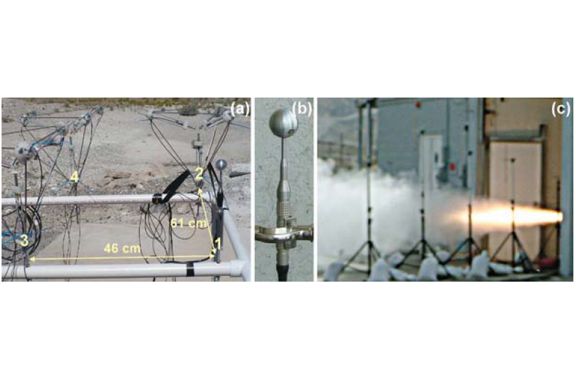
A statistical analysis of noise data from various-sized solid propellant rocket motors is presented. Time waveform data sampled at 204.8kHz using 6.35mm and 3.18mm microphones were collected near motors with nozzle exit diameters ranging from 0.13m to 1.22m. Non-Gaussian features of the data are explored by calculating estimates of the probability density functions of the data, its standard deviation, its skewness, and its kurtosis. This is carried out for both the pressure waveform and its first order time difference to reveal the formation of acoustic shocks within the noise. The analysis shows greater similarity between different rocket statistics for the pressure than for the time derivative.
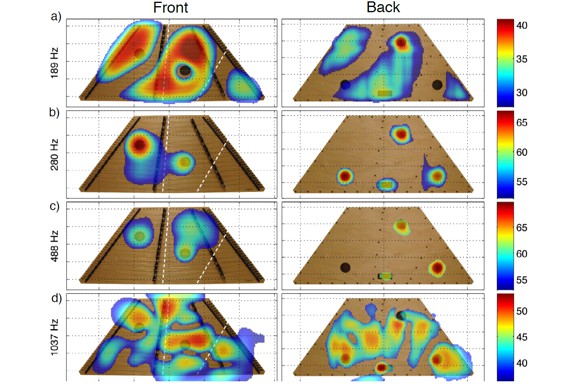
The contributions of cavity and structural resonances to the sound radiation from a hammered dulcimer have been investigated. Results indicate that the sound quality of the lowest notes is affected by a relatively weak structural resonance in that frequency range. Additionally, near-field acoustical holography indicates significant sound radiation from front and back sound holes at frequencies of importance, contradicting the commonly held notion that the dulcimer’s sound holes serve no acoustical purpose.
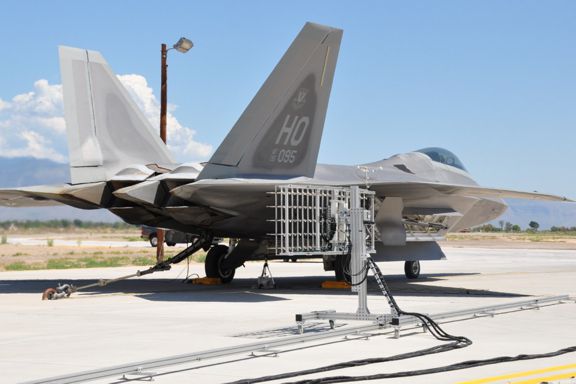
Since the 1950s the jet aeroacoustics community has been involved in predicting and measuring the noise distribution in jets. In this work, cylindrical and planar Fourier near-field acoustical holography are used to investigate radiation from a full-scale, installed jet engine. Practical problems involving measurement aperture and the highly directional nature of the source are addressed. Insights from numerical simulations reveal usable reconstruction regions. A comparison of cylindrical and planar NAH for the respective measurement apertures shows cylindrical NAH outperforms planar NAH on reconstructions both towards and away from the source.
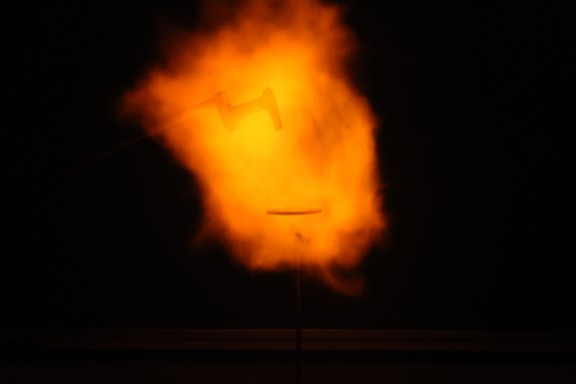
Exploding gas-filled balloons are common chemistry demonstrations. They provide an entertaining and educational means to experimentally verify nonlinear acoustical theory as described by the Earnshaw solution to the lossless Burgers equation and weak-shock theory. This paper describes the theory, the demonstration, and the results of a propagation experiment carried out to provide typical results. Data analysis shows that an acetylene-oxygen balloon produces an acoustic shock whose evolution agrees well with weak-shock theory. On the other hand, the pressure wave generated by a hydrogen-oxygen balloon also propagates nonlinearly, but does not approach N-wave-like, weak-shock formation over the propagation distance. High-speed video of these explosions provide discussion material on directionality of propagating acoustic shocks. Overall, the experiment shows that popular demonstrations of chemical reactions can be extended from chemistry classrooms to a pedagogical tool for the student of advanced physical acoustics.
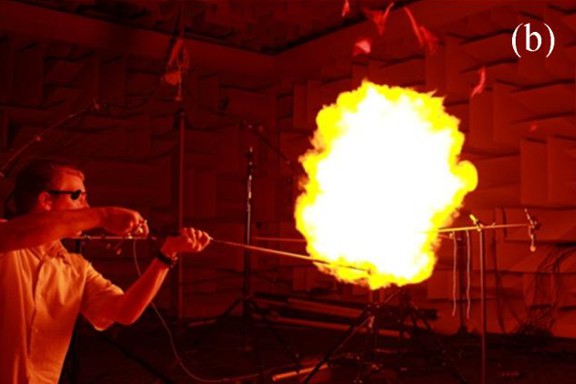
Exploding hydrogen-oxygen balloons are a popular demonstration in introductory chemistry and physical science courses. Initial research quantified potential hearing risk from exploding hydrogen-oxygen balloon demonstrations. Further time waveform and spectral analysis was conducted to characterize hydrogen-oxygen balloons as impulsive noise sources. Pure hydrogen balloons produce low levels (less than 140 dB) and inconsistent reactions. Balloons filled the stoichiometric ratio of hydrogen to oxygen produce very consistent results between trials. Hydrogen-oxygen balloons are also nearly omnidirectional, with little variation over angles. Levels for hydrogen-oxygen balloons increase as a function of balloon size and oxygen content. Comparison is provided with other impulsive noise sources, including various firearms, other explosive chemistry demonstrations, and firecrackers. Consideration is given to characteristics such as A-duration, rise time, and peak level. It is concluded that the hydrogen-oxygen balloons are less impulsive than other sources of similar amplitude, with longer A-durations and rise times. As such, the balloons have lower characteristic frequencies than other impulsive noise sources considered.
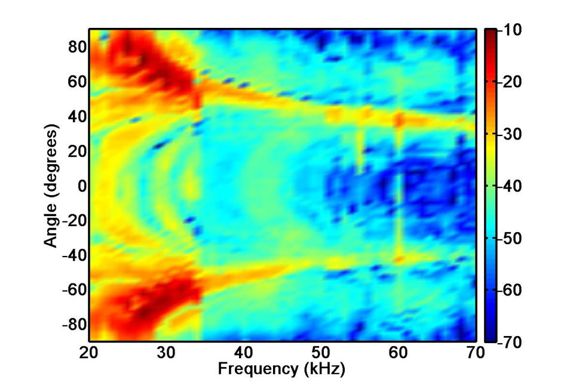
A method of measuring angular dependence of acoustic transmission through supercritical plates in air is discussed. The coincidence effect occurs in a supercritical plate when the component of the acoustic wave number parallel to the plate matches the bending wave number in the plate. The transmission of sound is a maximum at the angle where this trace wave number matching occurs. The theory of the coincidence effect is well-defined for unbounded thin plates using plane-wave excitation. However, experimental results for finite plates are known to diverge from theory, especially near grazing angles. An experimental setup has been developed in order to observe the coincidence effect using continuous-wave excitation and phased-array methods. Experimental results through a 0.5 mm thick aluminum bar exhibit strong maxima at the predicted coincidence angles, showing that coincidence is observable using continuous waves. Also, transmission near grazing angles is seen to diverge from infinite plate theory. Further work is suggested to improve the measurement setup and explore the source of the divergence.
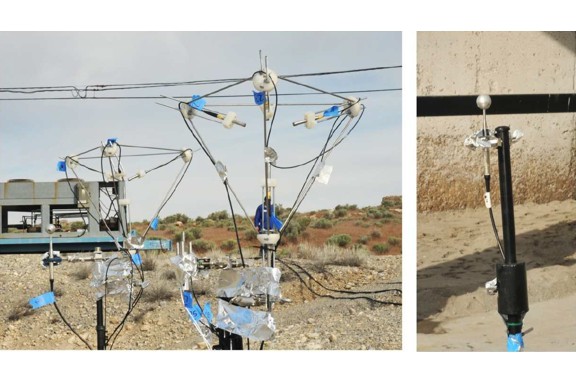
The acoustic field near large-scale solid rocket motors represents a harsh, high-amplitude noise environment rich with high-bandwidth acoustic shocks. Type-1 prepolarized microphones may be used in these environments with the benefit of reduced cost and measurement because they require only a constant-current supply available in many data acquisition systems. However, there are potential issues related to microphone response that should be considered. The main issue discussed here has to do with temporary failure of the constant-current supply due to an insufficiently fast response time in representing rapid voltage changes at shocks, which results in spurious, capacitive-like effects in the waveform data that are also manifest as a low-frequency roll-up in the spectrum noise floor. An experiment was conducted to identify under what circumstances these waveform effects arise. Data were measured from a solid rocket motor using several combinations of transducer, cable type, cable length and constant current supply. Results and mitigation methods found from the experiment are discussed. These include increasing the supply current, using low-impedance cables, and choosing the correct orientation for the transducers.
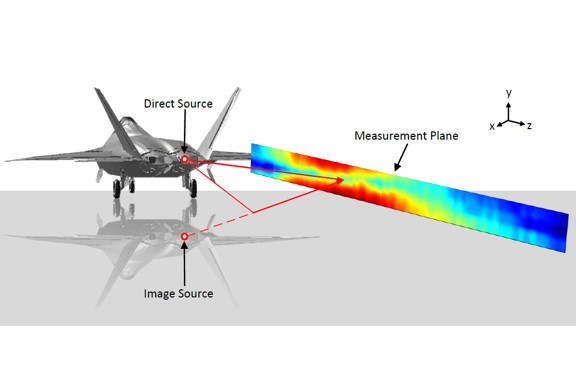
This study explores an alternative approach using a semi-empirical equivalent simple-source model to analyze and characterize the turbulence-induced aeroacoustic sources from military jet aircraft. Initially the model is a single point source located above a hard plane such that the locations of destructive interference from its mirror image matched the measured interference nulls. This provides useful information about the location of the dominant noise source region from the jet. The model then develops into a superposition of Rayleigh-distributed line arrays of uncorrelated and correlated monopoles. The model is tested on an extensive set of acoustic data taken on an F-22 Raptor. Although the model's line source characteristics are developed using data from only one measurement plane, it is able to accurately reproduce the radiation at other measurement planes. This equivalent line source matches the current prevailing theory that the sideline radiation is largely due to uncorrelated noise, whereas the correlated sources dominate downstream. In addition, the semi-empirical, simple-source model results corroborate the theory that the peak source location moves upstream with increasing frequency and lower engine conditions.

Scan-based near-field acoustical holography (NAH) is applied to partially correlated sources. Partial field decomposition via the virtual coherence method is used to implement the scan-based NAH. The background and theory of these methods are developed. Multiple stationary reference microphones are required for the partial field decomposition. Guidelines for reference microphone placement in the literature thus far have been limited. Improved guidelines for reference microphones are given after the results of two sets of experiments. The first set involves discrete, partially correlated sources, both physical and numerical. The second set of experiments is strictly numerical and involves continuous sources. Fewer microphones are required for partially correlated sources as compared to completely uncorrelated sources. Reference microphone number is found to be more critical to reducing holography reconstruction errors than is placement or location. For the continuous results, an appropriate figure of merit is created: reference microphones per coherence length. Based upon the definition of coherence length, two reference microphones per coherence length are required to minimize reconstruction error. Further practical reference microphone guidelines are given. These guidelines are to assist in preparing for a full-scale application of scanbased near-field acoustical holography to a military aircraft jet.
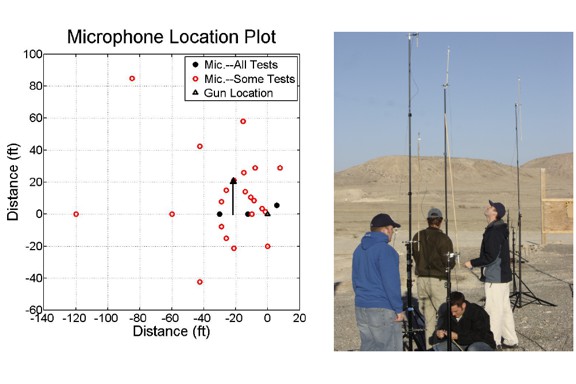
The United States Army Engineer District in Sacramento, California, selected HHI Corporation, a design-build construction and engineering firm of Farmington, Utah, to design and build an indoor test facility for the GAU-8 Avenger at Hill Air Force Base, Ogden, Utah. The blast pressures from this 30-mm Gatling gun, however, are large enough to cause spallation of the concrete walls over time. The facility is being designed and constructed to last for over 20 years, requiring several acoustical treatments. The pressures from the gun were measured outdoors, with maximum pressures exceeding 3000 Pa (163 dB) at a distance of 30 ft (9.1 m). A computer model of the room was designed using EASE, and impulse responses were generated at several positions. These impulse responses were convolved with an ideal blast wave pulse train to mimic the sound of the gun in the room. From these data and results collected from preliminary tests in the range, recommendations have been provided as to placement and types of necessary treatments. Final data confirm that the test facility meets all acoustical and occupational safety requirements.
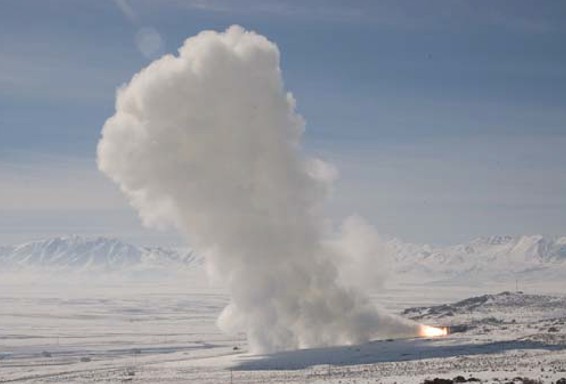
A one-micron diameter platinum wire resistance thermometer measures temperature fluctuations generated by propagating noise produced by a horizontally-fired, static GEM-60 solid rocket motor. A relationship between small amplitude acoustic pressure and acoustic temperature is derived and the data are compared with those calculated from pressure data recorded by a nearby 3.18 mm condenser microphone. The validity of taking acoustic temperature measurements in a rocket field is discussed, particularly the role of turbulence induced temperature fluctuations.
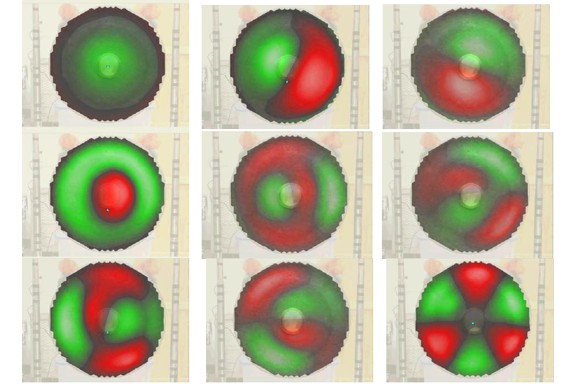
A large Balinese gamelan gong, the gong ageng wadon, is similar to other Indonesian gongs in that it is tonal. A previously undocumented phenomenon is the distinct acoustic beating this gong produces. In this study of the Brigham Young University's gong ageng wadon, acoustical and vibrometry measurements were performed. Scanning laser Doppler vibrometer results show a beat frequency of about 3 Hz is produced near 150 Hz and 160 Hz by closely spaced structural modes. A slightly slower beat frequency (around 2.5 Hz) is also produced at about 120 Hz. The difference in this case is that there is only one structural mode measured near this frequency. The acoustic radiation from this mode beats with a harmonic of the radiation from a lower structural mode, which harmonic is caused by nonlinear structural phenomena.
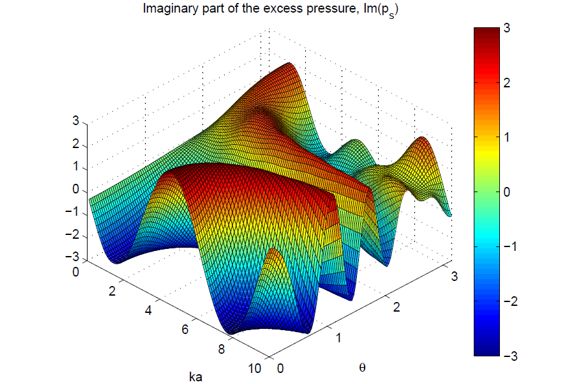
In order to facilitate the acquisition and accurate interpretation of intensity and energy density data in high-amplitude pressure fields, the expressions for intensity and energy density are examined to ascertain the impact of nonlinear processes on the standard expressions. Measurement techniques for estimating acoustic particle velocity are presented. The finite-difference method is developed in an alternate manner and presented along with bias and confidence estimates. Additionally, two new methods for estimating the local particle velocity are presented. These methods appears to eliminate the errors and bias associated with the finite-difference technique for certain cases.
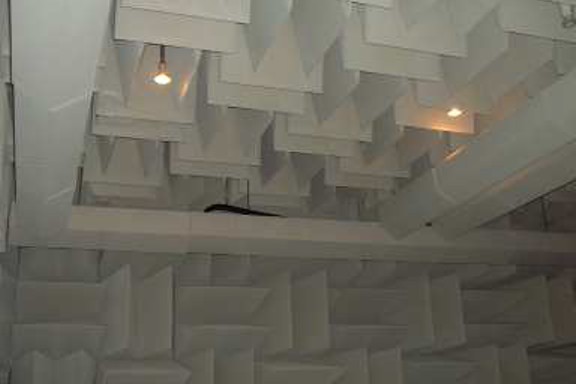
The implementation of an automated positioning and measurement system in the fully anechoic chamber at Brigham Young University is described. The system is employed to study the frequency generation of a hypersonic speaker. The general positioning system design consists of suspended rails for planar motion which are moved using stepper motors controlled by a computer. Con- siderations for mounting, acoustically absorptive insulation, system error han- dling, and automated measurement techniques are addressed. Software design and necessary functionality is outlined in detail. This system is useful for high-resolution measurements in stationary sound fields that could not be car- ried out with a reasonable number of channels or in a reasonable amount of time. The system is used to measure hypersonic speaker frequency generation of using driving signals of 500 Hz, 3 kHz, 10 kHz and all of those frequencies combined. The speaker is also studied using a white noise input signal.
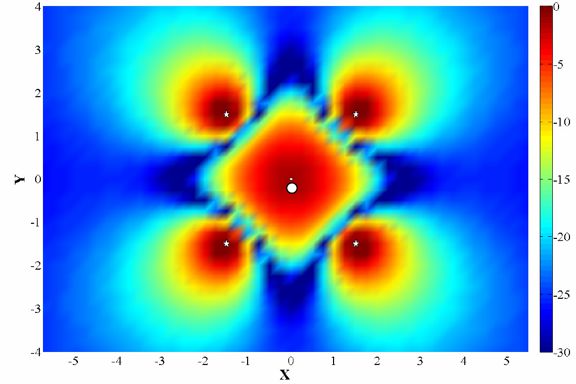
Recent experimental achievements in active noise control (ANC) for cooling fans have used near-field error sensors whose locations are determined according to a theoretical condition of minimized sound power. A theoretical point source model, based on the condition previously stated, reveals the location of near-field pressure nulls that may be used to optimize error sensor placement. The actual locations of these near-field pressure nulls for both an axial cooling fan and a monopole loudspeaker were measured over a two-dimensional grid with a linear array of microphones. The achieved global attenuation for each case is measured over a hemisphere located in the acoustic far field of the ANC system. The experimental results are compared to the theoretical pressure null locations in order to determine the efficacy of the point source model. The results closely matched the point source model with a loudspeaker as the primary source, and the sound power reduction was greatly reduced when error sensors were placed in non-ideal locations. A weakness of the current near-field modeling process is that a point monopole source is used to characterize the acoustic noise from an axial cooling fan, which may have multipole characteristics. A more complete characterization of fan noise may be obtained using a procedure based on the work of Martin and Roure [J. Sound Vib. 201 (5), 577–593 (1997)]. Pressure values are obtained over a hemisphere in the far field of a primary source and the contributions from point source distributions up to the second order, centered at the primary source, may be calculated using a multipole expansion. The source information is then used in the aforementioned theoretical near-field calculation of pressure. The error sensors are positioned using the complete fan characterization. The global far-field attenuation for the multipole expansion model of fan noise is compared to that of previous experiments. Results show that the multipole expansion model yields a more accurate representation the near field, but is not successful in achieving greater sound power reductions in the far field.
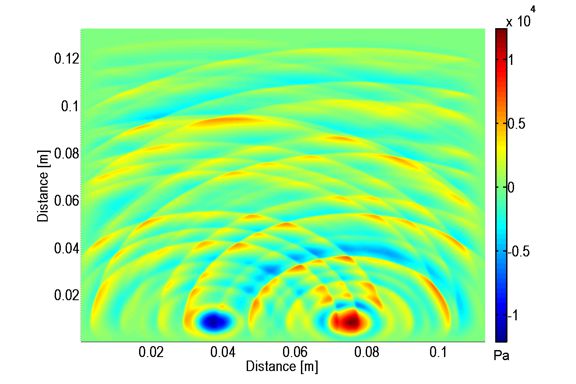
Near-field acoustical holography (NAH) has been used extensively for acoustical imaging of infinitesimal-amplitude (or small-amplitude) sources. However, recent interests are in the application of NAH to image finite-amplitude (or high-amplitude) sources such as jets and rockets. Since NAH is based on linear equations and finite-amplitude sources imply nonlinear effects, which cause shock formation and consequently an altered spectral shape, a feasibility study is carried out to determine the effect of nonlinear propagation on NAH. Jet and rocket sources typically have a distinct spectral shape resembling a ‘haystack’ and center frequencies varying from 30 to 300 Hz. To test the effect of nonlinear propagation on jet or rocket noise, several waveforms with varying spectral shapes and center frequencies were created and numerically propagated in one dimension using a nonlinear propagation algorithm. Bispectral methods were used to determine the amount and effect of nonlinearity, showing that higher center frequencies lead to more nonlinearities for a given amplitude. Also, higher-order statistical analysis of the time derivative of the waveforms was used to determine information about the relative amount of waveform steepening and shock coalescence occurring. NAH was then used to reconstruct the original waveform magnitude and the errors were determined. It was found that the ‘haystack’ spectral shape can be preserved by the nonlinear effects leading to low amplitude-reconstruction errors, whereas a narrow-band spectral shape will become altered and reconstruct very poorly. However, if nonlinear effects become strong due to higher center frequencies, longer propagation distances or higher amplitudes, even the ‘haystack’ shape will become altered enough to cause poor reconstruction. Two-dimensional propagation studies were also performed from two point sources, showing differences between linear and nonlinear propagation.
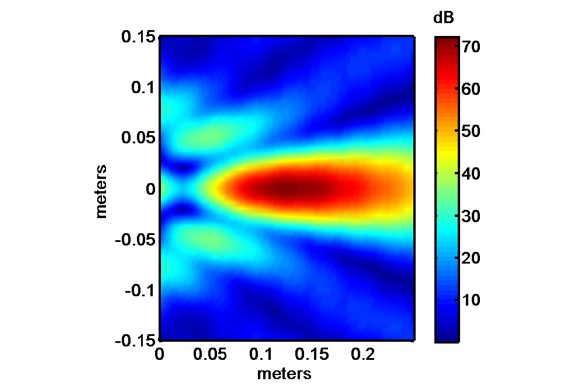
A balloon filled with a gas that has a different sound speed than that of air has been used by science teachers in the past as an ”acoustic lens.” One purpose of the lens is to show refraction of sound waves as an analogy to geometric optics [H. Kruglak and C. C. Kruse, Am. J. Phys. 8, 260-261 (1940)]. This paper discusses the physics involved with the balloon lens demonstration. In order to determine the validity of a gas-filled balloon as a classroom demonstration of an acoustic lens and to understand the corresponding phenomena, the problem is considered analytically, numerically, and experimentally. The results show that although a geometric analogy is a valid first order approximation, scattering theory is often required to fully understand the observed phenomena. Thus, this demonstration can be adapted to a wide range of students, from those learning basic principles of refraction to mathematically advanced students studying scattering.
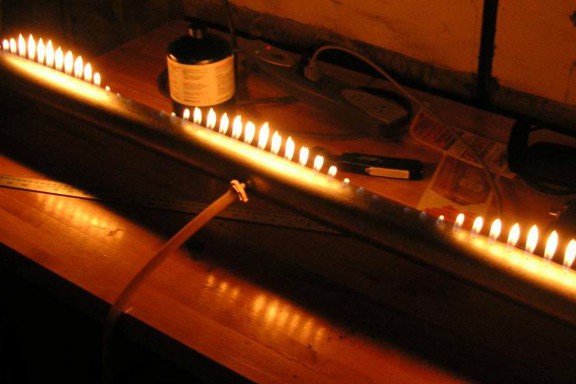
The Rubens flame tube is a teaching demonstration that is over 100 years old that allows observers to visualize acoustic standing wave behavior [H. Rubens and O. Krigar-Menzel, Ann. Phys. (Leipzig) 17, 149 (1905)]. Flammable gas inside the tube flows through holes drilled along the top, and flames are then lit above. The tube is closed at one end and is driven with a loudspeaker at the other end. When the tube is driven at one of its resonance frequencies, the flames form a visual standing wave pattern as they vary in height according to the pressure amplitude in the tube. Although the basic performance of the tube has been explained [G. Ficken and C. Stephenson, Phys. Teach., 17, 306-310 (1979)], this paper discusses the previously unreported characteristic of the tube’s resonance frequency shifts. This study observed that this phenomenon involves an upward shift of the natural frequencies of the lower modes from what would ordinarily be expected in a closed-closed tube. Results from a numerical model suggest that the shift is primarily due to a Helmholtz resonance effect created by the drilled holes. The numerical model is explained and the numerical results are compared to experimental findings and discussed.
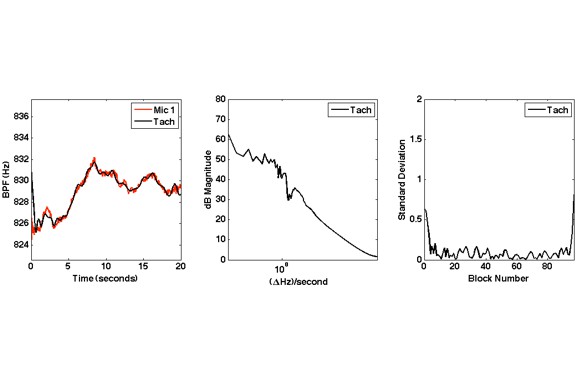
In the active control of tonal noise from cooling fans, one factor that can limit the achievable attenuation is fluctuation of the blade passage frequency in time. Large fluctuations in a short time can hinder the algorithm from converging to the optimal solution. Some fans have steadier speeds than others, which can be due to unsteady driving mechanisms or the physical structure of the fan. Environmental effects such as back pressure and unsteady blade loading can also cause the fan speed to fluctuate. The shifting in the blade passage frequency will be measured using a zero-crossing technique to track the frequency of each cycle. Blade passage frequency fluctuations will be presented for various driving mechanisms and environmental conditions. Techniques to minimize frequency shifting will also be discussed.
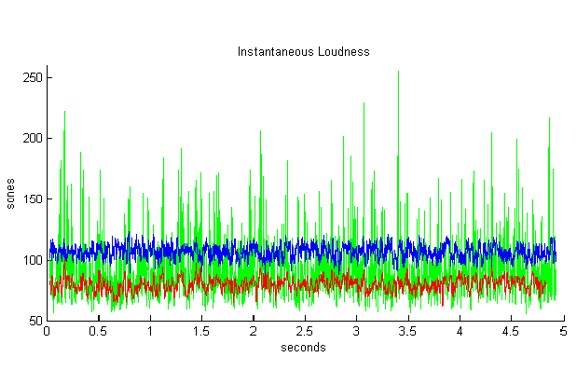
Interest in predicting the community impact of flyover noise from high-performance aircraft has stimulated research into metrics that accurately represent human perception of the loudness of the noise thus created. This problem is complicated by both human factors involved in the perception of the noise waveforms, and physical ones, particularly the nonlinear process that underlies the transmission of high-amplitude noise through the atmosphere. An introduction will be given to the process of nonlinear propagation and how it is modeled to give our simulated nonlinear waveform. The processes underlying loudness perception in the hearing system and the methods used in this project to model them will be discussed. The reaction of the time-varying loudness metric, as described by Moore and Glasberg, to simulated linearly and nonlinearly propagated signals will be discussed and compared to its reaction to a “rephased” signal, in which the power spectrum of the nonlinearly propagated signal is maintained but the Fourier phase randomized to eliminate the shocks. Qualitative perceived reactions to the waveforms will be compared the quantitative reaction of the metric. These will be considered in the light of recent research into the phenomenon of “crackle” and the importance of the first derivative of the wave form in the qualitative experience of crackle.
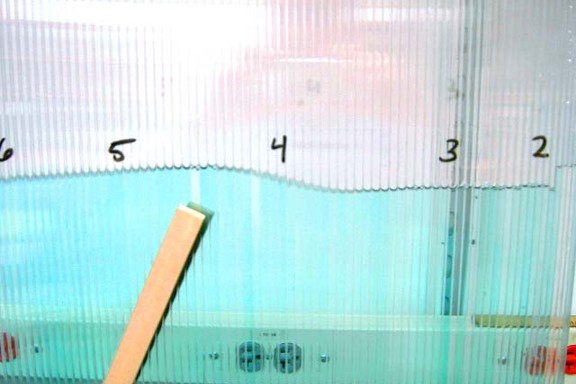
I have constructed a device that demonstrates the spectral decomposition of waves according to spatial location along a surface analogous to the function of the basilar membrane of the mammalian cochlea. The design is based on previous work done by Robert Keolian at Pennsylvania State University.1 I have modified Keolian’s design to incorporate variable mass as well as stiffness and an electronically driven shaker, which allows the device to be driven with complex waveforms. The model can be used to demonstrate beating, masking, and other psychoacoustical phenomena that occur on the basilar membrane.
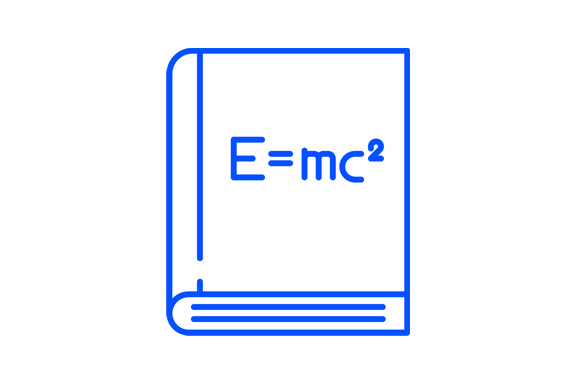
Understanding and accurately modeling the acoustic sources and propagation of high-intensity tactical jet aircraft and rocket noise is essential for vehicle design, environmental impact assessment, and mitigation strategies. Despite progress in the understanding of these sources, significant challenges persist in both predictive modeling and noise mitigation. This dissertation advances both the characterization of full-scale supersonic tactical jet aircraft noise sources and the development of modern empirical prediction models for rocket launch noise. Across multiple measurement campaigns and modeling efforts, the work integrates advanced array signal processing, high-fidelity field measurements, and improved empirical methods to expand the physical understanding of source mechanisms and deliver accurate, practical prediction tools. The first portion of this work focuses on acoustic source characterization for a full-scale, installed GE F404 engine operating at afterburner. Using coherence-based partial field decomposition methods, implemented via an equivalent source reconstruction with acoustical holography, apparent source distributions are resolved across frequency. A bandwidth extension technique employing array phase-unwrapping and interpolation enables detailed mapping of local maxima, distinct in frequency and space, along the nozzle lipline. Analysis reveals distinct subsources--ranging from possible large-scale turbulence in the convectively subsonic region to likely Mach wave radiation originating throughout the shear layer--along with regions of mixed source contributions producing spatiospectral lobes. Subsequent analysis addresses broadband shock-associated noise (BSN), a dominant high-frequency component in imperfectly expanded supersonic jets. Full-scale measurements from the installed F404 engine on the T-7A trainer aircraft identify BSN sources along the nozzle lipline, corroborated by in-situ imaging. Measured shock spacing deviates from current analytical predictions, impacting the performance of established BSN frequency models; however, accuracy is restored when models are corrected using measured shock cell spacing. Coherence analysis demonstrates coupling between upstream-directed BSN and downstream Mach wave radiation, as well as elevated coherence between shock cells, indicating a partially coherent, spatially distributed BSN source. Building on these source characterization efforts, a field measurement campaign measured the acoustic environment surrounding the Atlas V JPSS-2 launch from Vandenberg Space Force Base. Eleven measurement stations, ranging from 200 m to 7.7 km at multiple azimuthal angles, captured several details of the launch acoustics. These include both a 30 dB variation in ignition overpressure peak levels due to flame trench directionality and potential azimuthal asymmetry in the radiated noise field. These data form the foundation for subsequent empirical model development. A new set of simplified predictive relationships is presented for estimating overall acoustic power levels and maximum overall sound pressure levels from heated supersonic aircraft jet engines and rockets. Based on fundamental flow properties, these models demonstrate strong predictive performance for Atlas V and Vulcan Centaur launches, as well as for the installed GE F404 engine across several operating conditions, achieving root mean square errors of less than 2 dB for maximum unweighted sound levels. The final contribution is SATURN (Scientific Acoustic Tool for Understanding Rocket Noise), a modular, open research model that modernizes the legacy NASA SP-8072 framework. SATURN incorporates high-fidelity acoustic parameters derived from the Atlas V 401 dataset and an empirically derived propagation loss model for spectral levels. Validation against Firefly Alpha and SpaceX Starship launches yields 34 independent validation points over a broad range of distances. SATURN predicts the unweighted levels near peak radiation with a root-mean-square error of ~1 dB within 20 km, representing a factor of two or more improvement in acoustic pressure accuracy over SP-8072. Collectively, this work provides new physical insights into the source mechanisms of full-scale supersonic jets, delivers improved empirical tools for rocket noise prediction, and establishes a validated, modular modeling framework for future launch noise prediction applications. The combination of high-fidelity measurements, advanced source decomposition, and modernized prediction models offers a pathway toward more accurate and flexible acoustic assessment capabilities for aerospace applications.

ANSI/ASA standard S12.75 (2012) provides guidance on allowable meteorological conditions for acoustical measurements of installed high-performance jet engines. This paper investigates meteorological effects on acoustic data acquisition by analyzing recent measurements of a T-7A-installed GE F404 engine. During this measurement, the aircraft was run up six times at engine powers from idle to full afterburner, with test conditions following those prescribed by S12.75. However, far-field spectra show variability between runs, despite relatively uniform test conditions. Measurements of the vertical temperature gradient show a correlation between the gradient and spectral characteristics. This analysis suggests that local temperature profiles must be considered more carefully in future full-scale measurements.

When creating data-based models it is important to include the underlying physical characteristics and constraints of the data. If physical characteristics are not properly included in the model, results may be infeasible or physically impossible. Acoustic environments are better characterized by ensuring that models include the fundamental spatial, spectral, and temporal characteristics of noise sources, or how they change based on location, frequency, and time. When model data are limited, in availability or in reliability, additional care must be taken to ensure models predict feasible results. This dissertation focuses on physics-guided modeling of acoustic environments using limited data, taking into consideration spatial, spectral, and temporal characteristics of noise sources, specifically focused on wind noise and traffic noise. Wind noise contamination in spectral data can be significant, even when using a windscreen. By modeling spectral characteristics of temporally varying wind noise contamination, a method for automatically detecting and reducing wind noise was developed. Reducing non-acoustic wind noise contamination allows for better characterization of outdoor acoustic environments and is useful for accurately measuring other noise sources. Traffic noise varies spatially, spectrally, and temporally, and depends on traffic volume (the number of vehicles per unit time) and traffic class mix (e.g., the relative number of small vehicles compared to large trucks). Using the temporal variation found in reported traffic volume at thousands of locations, a model was developed to represent and predict the spatio-temporal variability of traffic volume nationwide. Further models were created to include dynamic changes in traffic class mix and to predict spectral source traffic noise. The resulting model for predicting source traffic noise is known as VROOM, the Vehicular Reduced-Order Observation-based Model. The physics-guided modeling techniques presented in this dissertation are intended for characterizing acoustic environments, which has applications for such diverse areas as human health and wellness, bioacoustics, wildlife conservation, urban and roadway planning, land development and conservation, noise ordinance legislation, homebuying, and more.
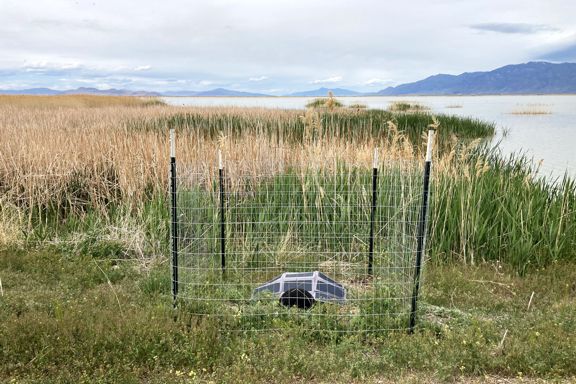
The avian dawn chorus takes place in the early morning and is characterized by marked increase of bird vocalization around sunrise. These choruses are very prominent when large bird communities are concentrated in one location, such as in a migratory bird refuge. Because the dawn chorus is such a prominent acoustic event in an ecosystem with large avian populations, monitoring the dawn chorus alone could provide insight into avian activities. It has been shown that many things can impact avian dawn choruses such as Julian Date, precipitation, temperature, lunar phase, and anthropogenic noise. In the U.S. Federal Fish and Wildlife Services Bear River Migratory Bird Refuge (BRMBR) in Utah, there is standing water in wetland units which dry up in the heat of summer. We monitored the refuge from March to August in 2021 using sound level meters at three different locations in the refuge. Using these data, we calculated the overall sound pressure level (OASPL) of the dawn chorus for every day we had a successful recording. Correlating the OASPL of several sites over the year with water levels at the site, we were able to find that there is a strong correlation between decreasing standing water levels and decreasing OASPL indicating a decrease in avian vocalization.
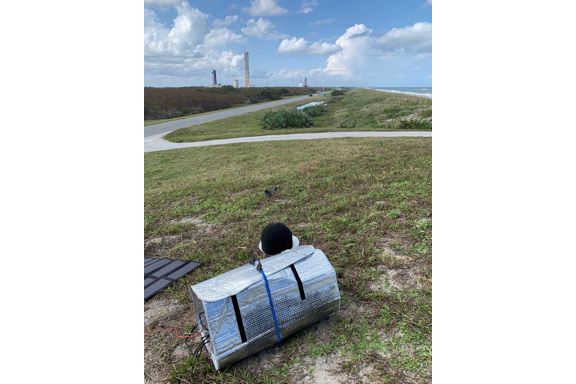
This thesis documents initial findings from far-field noise measurements made at NASA’s Kennedy Space Center during liftoff of the Space Launch System’s Artemis I mission, which occurred on November 16, 2022. The vehicle – the most powerful ever successfully launched into orbit – consists of four liquid-fueled RS-25 engines and two five-segment, solid-fuel rocket boosters (SRBs). Because this was the first launch, the noise radiation characteristics of this vehicle were previously unknown. Overall sound pressure levels, waveform characteristics, and spectra are described in the results section at distances ranging from 1.5 to 8.4 km. These are calculated from the pressure waveforms and range from 120-140 dB. The levels due to the SRBs’ ignition overpressure are particularly intense in the direction of the flame trench exit. The post-liftoff maximum spectrum has an average peak at 10 Hz. The sound levels distance corrected to 100 nozzle diameters was found to average to 142.6 dB. These findings further the understanding of super heavy-lift rocket acoustics.

Because the noise source mechanisms and radiation properties associated with high-thrust, tactical jet engines are not fully understood, analysis of full-scale measurements are conducted to improve the understanding of these characteristics. Two such analyses used in this thesis are: 1) compare spectral data to empirical models for jet noise spectra, and 2) calculate the coherence between microphones for varying frequencies. This paper compares measured near-field spectra from a T-7A-installed GE F404-103 engine with analytical similarity spectra for fine-scale mixing noise, large-scale mixing noise, and broadband shock-associated noise. It also compares the coherence to narrowband autospectral density levels at specified frequencies. The similarity spectra and coherence analyses enable the determination of spatial trends in overall sound pressure level, peak frequency, and spatiospectral lobes. They also help determine the relative importance of each type of noise radiation as a function of location. This approach is used to gain insights on spatial and frequency trends for different engine conditions. Additionally, it is used for rapid comparisons to analyses of other aircraft and jets of other scales and conditions.
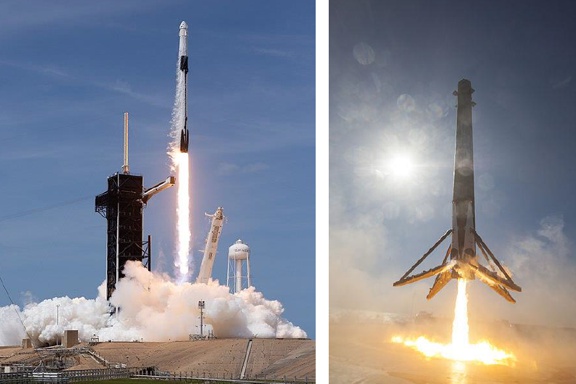
A downside of landing first-stage boosters of orbital-class launch vehicles, such as the Falcon 9, is the sonic boom associated with reentry and landing. To assess the potential impact of these sonic booms and compare them to launch and landing operations, acoustic data from a Falcon-9 launch and booster landing at Vandenberg Space Force Base are analyzed. The data were collected near Lompoc, CA, at a station 8 km away from the landing site. Because of the booster shape and landing orientation, the measured waveform contains three shocks (a triple boom), rather than the two associated with a traditional N-wave. Waveform and spectral characteristics are examined and various metrics, including A-weighted Sound Exposure Levels, are calculated and compared with those of the launch and landing noise.
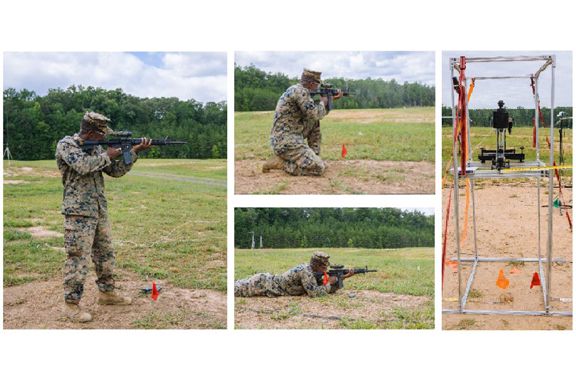
Small firearms can create sound levels exceeding the safe threshold of human hearing with even one shot. Understanding how the sound propagates will lead to better range and military drill design. This thesis describes errors associated with different predictive interpolation models for the M16A4. Before directly discussing potential sources of error, the thesis first seeks to validate the data acquired. This is done through waveform inspection with a focus on shot-to-shot consistency. Finding the standard deviation in level between a 10-shot volley provides a good baseline with which other sources of error can be compared to. For both peak and 8-hour A-weighted equivalent levels, the deviation tended to be 1-1.2 dB. With this constraint in mind, the thesis then discussions potential error of measurements along the radial arc. By comparing nearest neighbor microphones with measured values, it was determined that a finer resolution behind the shooter is most relevant. Second, radial propagation was plotted to justify potential decay rates for further plotting. A model of spherical spreading is reasonable, but overestimates the level at farther distances e.g. 50 m. Lastly the thesis focuses on interpolation mapping to predict levels around the range. The baseline model was created using a Cartesian interpolation scheme that uses ghost points to help limit potential artifacts. Leave-one-out analysis highlighted a necessity of microphone placement behind the shooter and other less important microphones. Use of symmetry across the firing direction provides excellent results, generally below the 1 dB standard deviation. In the end, a best-practices guideline is given, which reduces number of required microphones by half. Through these analyses, future measurements will be more effective in microphone placement. With these level maps, one will also be able to better determine potential hearing risks associated with small firearm use and even avoid them through better drill.
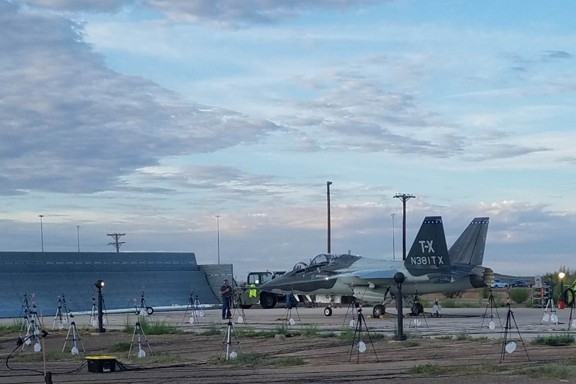
Better phenomenological noise source models for full-scale military aircraft can enhance current noise mitigation efforts for military aircraft. Similarity spectra analysis is a common method for identifying both the fine-scale and large-scale spatial components of jet noise. For an imperfectly expanded supersonic jet, the addition of a broadband shock-associated noise model helps to better fit the spectral shape of measured full-scale jet noise. A similarity spectra analysis of T-7A-installed GEF404 engine noise has been performed at intermediate to full afterburner conditions. The broadband shock-associated noise contributions are significant for military and afterburner conditions. The combined model captures the noise reasonably well with some caveats. First, spatiospectral lobes present in the measured noise are not well represented. Second, the measured low-frequency spectral slope is steeper at higher engine conditions in the region of maximum radiation. Third, the measured high-frequency slope is shallower across most of the radiation angles. Fourth, the noise at large inlet angles, beyond the peak radiation lobe, is not well represented by the combined model. The successes and failures of this model for different spatial regions and frequencies will aid in developing improved models for noise radiation.
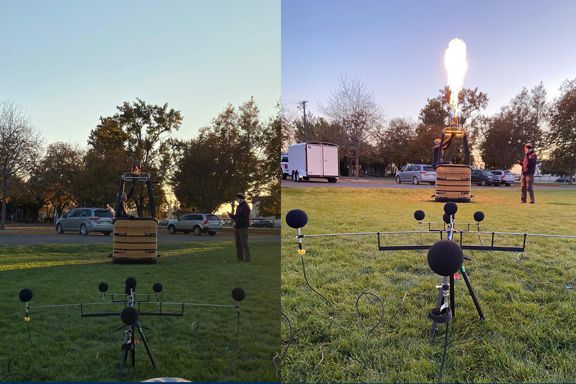
This thesis describes the phase and amplitude correction of 12.7 mm diameter, Type-1 microphones for three frequency bands, including within the infrasound regime, and its application to acoustic measurements. Previous data stem from acoustic intensity measurements using two-dimensional, four-microphone probes, which emphasized the requirement of having the acoustic phase and amplitude difference be much greater than the interchannel mismatch. Although correcting the amplitude/phase is well-known, obtaining the necessary transfer functions in the infrasound regime is challenging because (1) signal-to-noise ratios are often poor, (2) long measurement times are required for averaging, and (3) microphone responses vary significantly across these low frequencies. In this paper, a convenient infrasound source previously studied for infrasound adverse effects on humans is intended for performing a relative calibration. This work also seeks to elaborate recommendations for probe spacing, averages or length recordings, and instrument mismatch. The last two chapters show the PAGE method application in infrasonic sources. Those chapters have the intensity measurements using free-field microphones with larger separation distances than commercial intensity probes but compact compared to state of the art in infrasonic arrays.
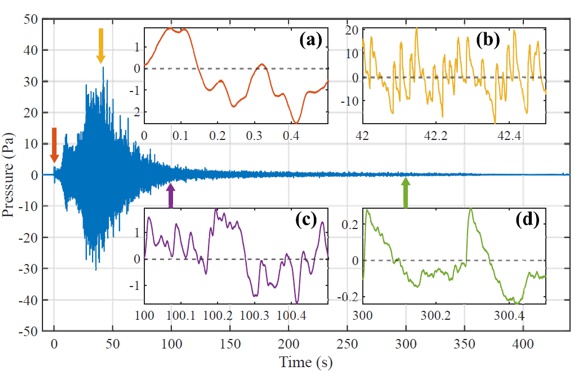
This study investigates the source characteristics of the Falcon 9 rocket from a series of measurements and evaluates models for maximum overall level, directivity, and radiated sound power. These models are based on a handful of rocket parameters and provide a basic description these rocket source characteristics. The models for maximum level and sound power perform well, while the angle of maximum radiation falls between historic predictions for static and launched vehicles.
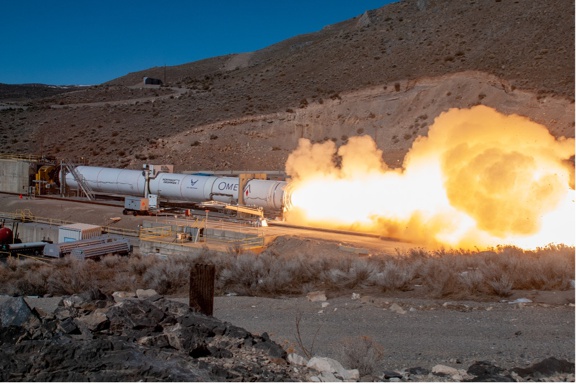
An improved microphone configuration for making outdoor sound measurements has been studied. This configuration, nicknamed the Compact Outdoor Unit for Ground-based Acoustical Recordings (COUGAR), consists of an inverted microphone placed above a circular plastic plate and covered with a dome wind screen. The second generation of COUGAR, known as COUGARxt, follows the same general design but with a thinner plastic plate and a thicker wind screen. These two configurations, COUGAR and COUGARxt, along with an Elevated microphone configuration, have been tested in the BYU large anechoic chamber at various elevation and rotation angles relative to a noise source. The COUGAR and COUGARxt configurations have been tested on field tests involving rocket motor noise. Results indicate that both configurations record reliable acoustic data. Compared to COUGAR, COUGARxt is shown to vary less with rotation relative to the sound source and to reduce more low-frequency wind noise. As expected, the Elevated microphone configuration is shown to experience multi-path interference at all tested elevation angles when placed on a hard reflecting surface.
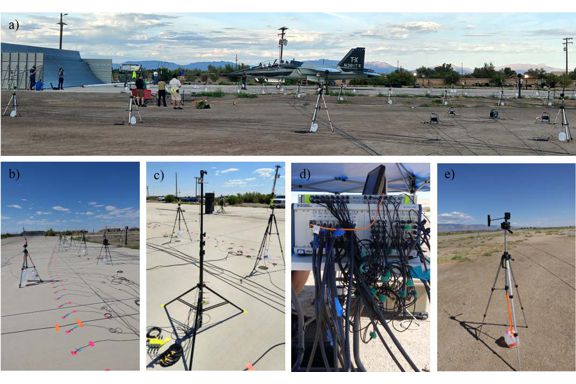
The sound produced by military aircraft is dominated by noise generated by the turbulent mixing of the jetted exhaust with the ambient air. This jet noise has the potential to annoy the community and pose a hearing loss risk for military personnel. The goal of this dissertation is to characterize spatiospectral features in the field produced by full-scale military aircraft that are not traditionally seen at the laboratory scale and identify potential noise mechanisms for these features. Measurements of two military aircraft jet noise fields are found to be best described as a superposition of spatiospectral lobes, whose relative amplitudes dictate the overall directivity at each engine power. Near-field acoustical holography techniques are applied to one of the military aircraft measurements to characterize the behavior of the lobes as a function of engine power. The simulated jet noise of a highly heated laboratory-scale jet is then analyzed to compare with the military aircraft measurement and is found to only partially contain the spatiospectral lobe phenomenon. Application of near to far field coherence tracing and near-field acoustical holography to the simulations provides validation of the methods used on the military aircraft and illuminate potential source mechanisms that may explain the presence of the spatiospectral lobes.
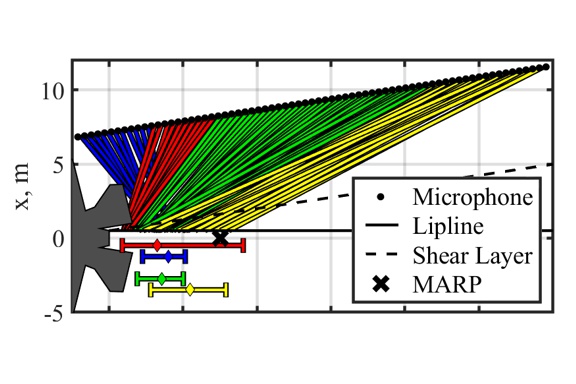
Crackle is a perceptual feature of supersonic jet noise that is related to the presence of acoustic shocks. The skewness of the time-derivative of the pressure waveform, or derivative skewness, is used as a metric indicative of crackle perception. The three main objectives of this work are: 1) Determine the potential spatial origin of crackle-related events in the near field of a high-performance military aircraft via an event-based beamforming method. 2) Investigate the potential for nonlinear, irregular shock reflections occurring along the near-field ground array and their implications on derivative skewness. 3) Relate the near-field, crackle-related events to far-field crackle perception by comparing nonlinearly propagated waveforms with measured far-field data. The event-based beamforming method used to determine source and far-field relationship of shock-like events utilizes the cross correlation between adjacent microphone waveform segments to determine the angle of propagation for an ensemble of crackle-related events within the waveform. The angle of propagation is traced towards the source for each event to find its apparent origin along the jet lipline. Beamforming results indicate that crackle-related events appear to originate anywhere from 2 to 14.5 m downstream along the jet lipline, with distributions that shift downstream and broaden with increasing engine power. The shock reflection classification method builds on the event-based beamforming method to calculate angle of incidence relative to the ground for an ensemble of shock events. The combination of angles of incidence and the measured shock strengths of the events reveal that irregular reflections are likely to occur over the majority of the array, which likely elevates the derivative skewness values due to steeper shocks with greater peak-to-peak pressures relative to off-ground measurements. Near-field, crackle-related events are extrapolated to the far field using a nonlinear propagation model to determine their prevalence in the far field. Cross-correlation coefficients of waveform segments centered about the propagated events indicates that for farther aft angles, near-field events are more related to far-field measurements. Waveform observations show that shock-like events in the near field that are more spiked in nature tend not propagate into the far field. However, near-field, large-derivative events with broader, high-pressure peaks nonlinearly steepen and form shocks in the far field that are likely contribute to crackle perception.
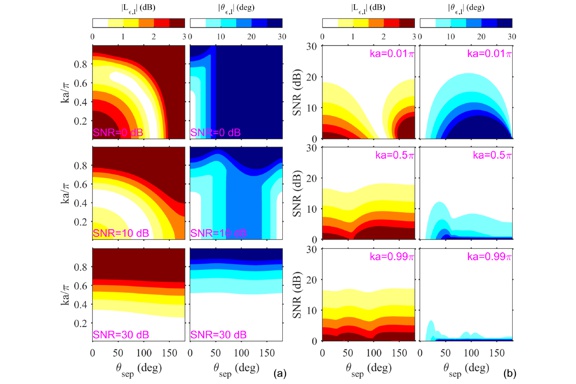
Coherence, which gives the similarity of signals received at two microphone locations, can be a powerful tool for calculating acoustic quantities, particularly active acoustic intensity. To calculate active acoustic intensity, a multi-microphone probe is often used, and therefore coherence between all microphone pairs on the probe can be obtained. The phase and amplitude gradient estimator (PAGE) method can be used to calculate intensity, and is well suited for many situations. There are limitations to this method—such as multiple sources or contaminating noise in the sound field—which can cause significant error. When there are multiple sources or contaminating noise present, the coherence between microphone pairs will be reduced. A coherence-based approach to the PAGE method, called the CPAGE method, is advantageous.Coherence is useful in phase unwrapping. For the PAGE method to be used at frequencies where the probe microphone spacing is larger than half a wavelength (above the spatial Nyquist frequency), the phase of transfer functions between microphone pairs must be unwrapped. Phase differences are limited to a 2π radian interval, so unwrapping—adding integer multiples of 2π radians to create a continuous phase relation across frequency—is necessary to allow computation of phase gradients. Using coherence in phase unwrapping can improve phase gradient calculation, which in turn leads to improved intensity calculation.Because phase unwrapping is necessary above the spatial Nyquist frequency, the PAGE method is best suited to dealing with broadband signals. For narrowband signals, which lack coherent phase information at many frequencies, the PAGE method can give erroneous intensity results. One way to improve calculation is with low-level additive broadband noise, which provides coherent phase information that can improve phase unwrapping, and thereby improve intensity calculation. There are limitations to this approach, as additive noise can have a negative impact on intensity calculation with the PAGE method. The CPAGE method, fortunately, can account for contaminating noise in some situations. A magnitude adjustment—which arises naturally from investigation of the bias errors of the PAGE method—can account for the additional pressure amplitude caused by the contaminating noise, improving pressure magnitude calculations. A phase gradient adjustment—using a coherence-weighted least squares algorithm—can likewise improve phase gradient calculations. Both adjustments depend upon probe microphone coherence values. Though not immune to contaminating noise, this method can better account for contaminating noise. Further experimental work can verify the effectiveness of the CPAGE method.

Nonlinear propagation and shock formation are shown in noise radiated from full-scale military jet aircraft. Perception of sound is not only affected by the overall sound pressure level of the noise, but also characteristics of the sound itself. In the case of jet noise, acoustic shocks within the waveforms result in a characteristic commonly referred to as"crackle." The origin of shocks in the far-field of jet noise is shown to be through nonlinear propagation. Metrics characterizing the shock content of a waveform are explained and given physical significance, then applied to jet noise at various distances and engine conditions to show areas where shock formation is significant. Shocks are shown to develop at different distances from the aircraft, dependent on the amplitude and frequency, and nonlinear propagation is shown to be important in determining time and frequency characteristics of jet noise at distances of up to 1220 m from the aircraft. The shock content is also characterized during flyover experiments, and the shock content between the two scenarios is compared. While some reduction in overall level and shock content is seen in the maximum radiation region, level increases in the forward direction during flight result in increased shock content. Variation at distances of 305 m and beyond is considered and shown as a result of small atmospheric changes. Finally, a nonlinear numerical propagation scheme is used to model the propagation, showing accuracy in predicting frequency-domain and time-domain features that are evidence of nonlinear propagation.
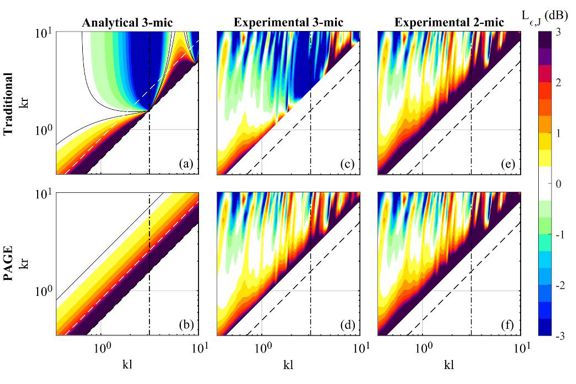
Energy-based acoustic quantities provide vital information about acoustic fields and the characterization of acoustic sources. Recently, the phase and amplitude gradient estimator (PAGE) method has been developed to reduce error and extend bandwidth of energy-based quantity estimates. To inform uses and applications of the method, analytical and experimental characterizations of the method are presented. Analytical PAGE method bias errors are compared with those of traditional estimation for two- and three-microphone one-dimensional probes. For a monopole field when phase unwrapping is possible, zero bias error is achieved for active intensity using three-microphone PAGE and for specific acoustic impedance using two-microphone PAGE. A method for higher-order estimation in reactive fields is developed, and it is shown that a higher-order traditional method outperforms higher-order PAGE for reactive intensity in a standing wave field. Extending the applications of PAGE, the unwrapped phase gradient is used to develop a method for directional sensing with improved bandwidth and arbitrary array response.
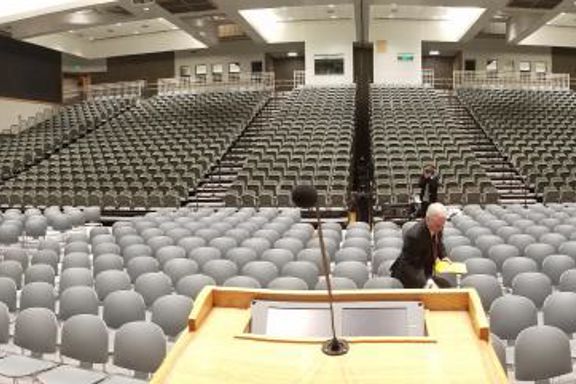
Acoustical room characterization typically involves a lot of high end and expensive equipment for measuring, modeling, and finding solutions to problems. Recently, Room EQ Wizard (REW) was introduced to BYU as a less costly option. This paper will evaluate REW's effectiveness through the metrics of mapping sound coverage, reverberation time and clarity calculations, while providing the Missionary Training Center with acoustical consulting for their auditorium. REW proved to be efficient and effective in all metrics and helped narrow the problem down to an unforeseen interaction between the loudspeakers and podium microphone.

Sound generation and radiation properties are studied of full-scale tactical jet engine noise. This is motivated by the high sound exposure levels from jet noise, particularly for tactical engines. Acoustic source reconstruction methods are implemented computationally on existing jet noise data. A comparative study is performed using numerical simulations to understand the capabilities of more advanced beamforming methods to successfully estimate the source properties of a distributed, partially correlated source distribution. The properties and limitations of each beamforming method are described. Having validated the methods, beamforming with regularization—via the Hybrid Method—is implemented on linear array measurements near an installed tactical engine. A detailed analysis of the correlation and coherence properties associated with the phased array measurements guides the implementation of the beamforming. When the measurements are used as inputs to the beamforming, they produce partially correlated, distributed sources in a full-order model representation. A processing technique is also implemented that increases the usable bandwidth of the array measurements to almost an order of magnitude above the array design frequency. To more appropriately study the equivalent sources, a decomposition technique is designed and implemented to create a reduced-order wavepacket model of the jet noise. The wavepacket model is modular and scalable to allow for the efficient characterization of similar jet noise measurements. It is also appropriate for its physical significance, as wavepackets are attributed to the turbulent flow as well as the hydrodynamic and acoustic properties of the radiation. The reduced order model can estimate the levels and coherence properties of the acoustic radiation and represents a significant step towards a complete jet noise prediction model.

Acoustic intensity measurements traditionally use cross spectral processing methods with multi-microphone probes to estimate pressure and particle velocity. In 2015, Thomas showed that the phase and gradient estimator (PAGE) method increases probe bandwidth without modifying microphone spacing as compared to the traditional cross spectral method. In this study, acoustic intensity is estimated by both the PAGE method and the traditional method across two commercially built 3D intensity probes and three in-house built 2D intensity probes. Probe performance is compared in a broadband, white noise, anechoic sound field radiated from a loudspeaker. Probe orientation is considered by rotating each probe over a 360 degree horizontal plane at 2.5 degree increments. Results show increased frequency bandwidth using the PAGE method across all probe designs. 3D intensity level estimates suffered the least amount of error with the spherical probe. 2D intensity level and direction estimates suffered the least error with the 2D triangular probe with ½” microphones spaced at 2”. Measurement limitations concerning the 2D triangular probes with ¼” microphones are discussed

Energy quantities, which are calculated from pressure and particle velocity, yield a great deal of information about acoustic fields. Errors in pressure or particle velocity estimation lead to bias errors the estimation of energy quantities. The bias errors arise from different probe configurations and processing methods. Two processing methods are examined: the traditional method and the recently developed Phase and Amplitude Gradient Estimation (PAGE) method. These two methods are compared to investigate how each estimates pressure and particle velocity and the subsequent bias errors in a plane wave, standing wave, and spherical spreading wave field. Analytical expressions are derived for the energy quantity estimation using ideal one-dimensional probes. A simulation of the field from a baffled circular piston and measurements using ideal two-dimensional probes is computed. Compared to the traditional method, the PAGE method significantly extends the range of frequencies for which the results are accurate. It is found that a probe with a center microphone significantly reduces the estimation error and extends the usable range of frequencies. The PAGE method with unwrapping, perfectly matches the analytical results for plane waves, while the traditional method is only good at wavelengths that are large compared to the probe size. Furthermore, the PAGE method has a constant bias error in spherical wave fields due to the 1/r decrease in pressure. The traditional method has a frequency dependent bias error that is much worse at higher frequencies. Lastly, the PAGE method has the same or worse error for the standing wave. As an application of energy quantities, acoustic intensity is used to develop an equivalent source model for jet noise from an F-22 at military and afterburner engine conditions. An optimization is used to find the best-matching wavepacket model for measured intensity vectors. The results are compared to another intensity method of estimating the source region and source directivity, and the two methods have good agreement.

Understanding the impact of jet noise and other high-amplitude sound sources can be improved by quantifying the nonlinearity in a signal with a single-microphone measurement. An ensemble-averaged, frequency-domain version of the generalized Burgers equation has been used to derive a quantitative expression for the change in spectral levels (in decibels) over distance due to geometric spreading, thermoviscous absorption, and nonlinearity, respectively. The nonlinearity indicator, called νN, is based on the quadspectral Morfey-Howell indicator, which has been used in the past to characterize nonlinearity in noise waveforms. Unlike the Morfey-Howell indicator, the νN indicator has direct physical significance, giving a change in decibels per meter of the sound pressure level spectrum specifically due to nonlinearity. However, a detailed characterization of the expected behavior and potential issues for the nonlinearity indicator has been lacking. The quadspectral nonlinearity indicator is first calculated for well-known solutions to several basic acoustical scenarios to determine its expected behavior in both the near field and far field. Next, the accuracy of νN is examined as a function of measurement parameters such as sampling frequency, signal bandwidth, scattering, and noise. Recommendations for conducting experiments are given based on the findings. Finally, the indicator is calculated for model-scale and military jet noise waveforms. These tests reveal the utility and accuracy of the νN indicator for characterizing broadband noise; the indicator gives frequency-dependent information about the waveform from a single-point measurement.

A recently developed phase and amplitude gradient estimator (PAGE) method for calculating acoustic intensity from multiple pressure measurements [Thomas et al., J. Acoust. Soc. Am. 134, 4058 (2013)] has been tested via anechoic laboratory measurements of the radiation from broadband sources. The measurements determine that the effective frequency bandwidth of valid acoustic intensity calculations can be substantially increased when using the PAGE method over the traditional cross-spectral approaches. Preliminary results are shown for two probe sizes and multiple broadband source configurations.

Mach stem formation in acoustic shocks is investigated using oxyacetylene balloon explosions conducted a short distance above pavement. As the shock wave propagates away from the blast site it transitions from a regular reflection to irregular reflection. The location of this transition point, as well as the path of the triple point, are experimentally resolved using microphone arrays and a high-speed camera. The measured transition point falls between that predicted from derivations based on weak shock waves and an empirical relationship derived from large-scale explosions. It also agrees well with predicted values based on von Neumann’s three shock theory.